
How close have you ever been to a shark? Did the magnificent creature swim away before you had a chance to ready your camera? Or perhaps someone around you gave chase, only to find the shark quickening its pace, fleeing from the disturbance. What if I told you there's a place where you can swim freely with these majestic predators? A place where you can observe their natural behaviors, and spend hours underwater with them? Welcome to the world of private shark diving with Dreaming Sea Divers in Jupiter, Florida.
It's important to debunk some myths here. When most people think about sharks, they envision a dangerous, aggressive beast, thanks to sensationalized media portrayals. But the reality is quite different. Sharks are generally wary of divers. They find our noisy movements, bubble outputs, and tight-fitting black suits less than appealing. They tend to leave us alone, unless of course, we're offering them a tantalizing meal. It's not that they're interested in us, but rather, the delicious food we bring to their territory.
Venturing into federal waters, over three nautical miles offshore, we navigate towards popular dive sites frequented by an array of sharks. Here in Palm Beach, we're fortunate to be surrounded by Silky, Dusky, Lemon, Bulls, Reef, Great Hammerhead, Scalloped Hammerhead, Nurse, Sandbar, and even the occasional Tiger Shark. Each species exhibits unique behaviors towards divers, yet none display aggression. Instead, they are awe-inspiring, majestic creatures worthy of our respect and admiration.
One such remarkable resident of these waters is Snooty, a renowned lemon shark believed to be the most photographed shark in the world! Such is her celebrity status that she even boasts her own Facebook Page. Both Snooty and the occasional Tiger sharks enjoy special attention from the divers.
Ensuring a safe and enjoyable dive experience, John, who has been feeding sharks professionally since 2015, guides us through our underwater adventure. As with all SCUBA diving experiences, shark diving carries inherent risks. However, diving with a trusted operation and an experienced feeder significantly minimizes these risks, without eliminating them entirely. So remember, always pay attention to diving and safety briefings.
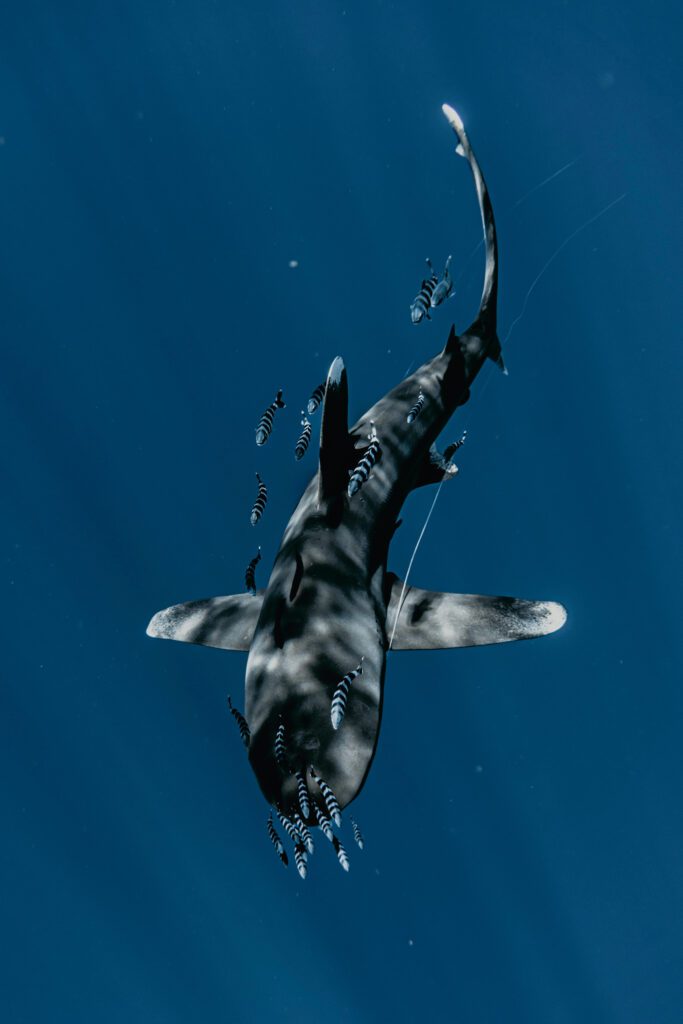
But enough about the logistics. Ready your cameras, or simply prepare to make unforgettable memories, and let's dive into the underwater world of sharks!
Beyond the shark diving experience, West Palm Beach offers an extraordinary diversity of marine life, depths, and bottom compositions. Thanks to our close proximity to the Gulf Stream, we are blessed with clear blue water and a bustling marine highway, brimming with life.
From June through July, the waters are a turtle lover's paradise, with Leatherback, Green, and Loggerhead Turtles nesting on the beaches and swimming back to the reefs to rest. August and September bring dozens of Volkswagen Beetle-sized Goliath Groupers to our wrecks, often surrounded by clouds of baitfish.
Florida SCUBA Diving is a world apart. Palm Beach's dive sites are bustling with moray eels, angel fish, butterfly fish, grunts, snappers, and numerous types of turtles. Occasionally, we are graced by the presence of Manta Rays, Whale Sharks, and even Great White Sharks!
Reef diving in Palm Beach offers beautiful reefs starting around 40ft (12m) on top and reaching 60ft (18m) in the sand. Our wrecks, sunk artificially to attract marine life and promote coral growth, start at 65ft (20m) and provide thrilling exploration opportunities.
The game fish variety on our reefs is fantastic, including Hogfish, many species of snapper and grouper, and cobia. And if you fancy hunting for your own dinner, the lobster hunting season from early August to the end of March offers an exciting venture!
Finally, the world-renowned Blue Heron Bridge at Phil Foster Park beckons. For decades, divers have flocked here to spot and photograph rare creatures hard to find anywhere else, all within a maximum depth of 23ft (7m).
So, are you ready for the adventure of a lifetime? Grab your gear, take the plunge, and join us at Dreaming Sea Divers. Dive deep into the world of sharks, and who knows what else we may find together in the mesmerizing waters of Palm Beach.
Are you looking to share your love of SCUBA and educate others? There’s no better way to do so than becoming a SCUBA instructor. Our private SCUBA instructor diving courses open the door for serious divers to turn their passion into a way of life. With the determination, practice, and proper certifications, you’ll be able to teach people about the sport you love – and get paid in the process. Join Dreaming Sea Divers for Instructor Development Courses, happening October 16th-24th, 2022!
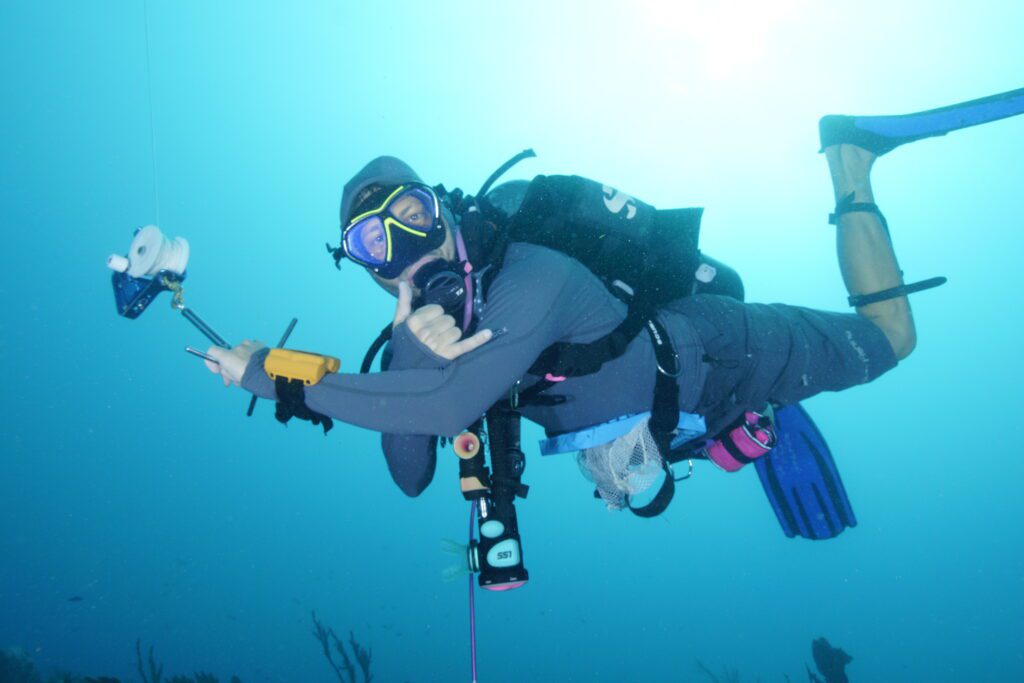
This private SCUBA certificationcourse enables participants to obtain the first level of professional diver in the SCUBA industry: Divemaster. This distinction will allow you to work in the industry to guide certified divers, assist instructors with training, and teach a select number of courses (like refreshers).
Those interested must be 18 years or older, have a minimum of 40 logged dives, and must bring their own basic SCUBA equipment. Additionally, a Rescue Diver and CPR Cert from and recognized agency is a prerequisite. Throughout the course’s instruction, participants will conduct activities like:
Please note that the Divemaster Course does not include rental gear, so come prepared! For more information, visit the course event page. We’re excited for you to partake in our West Palm Beach SCUBA instruction to become a role model and mentor to fellow divers!
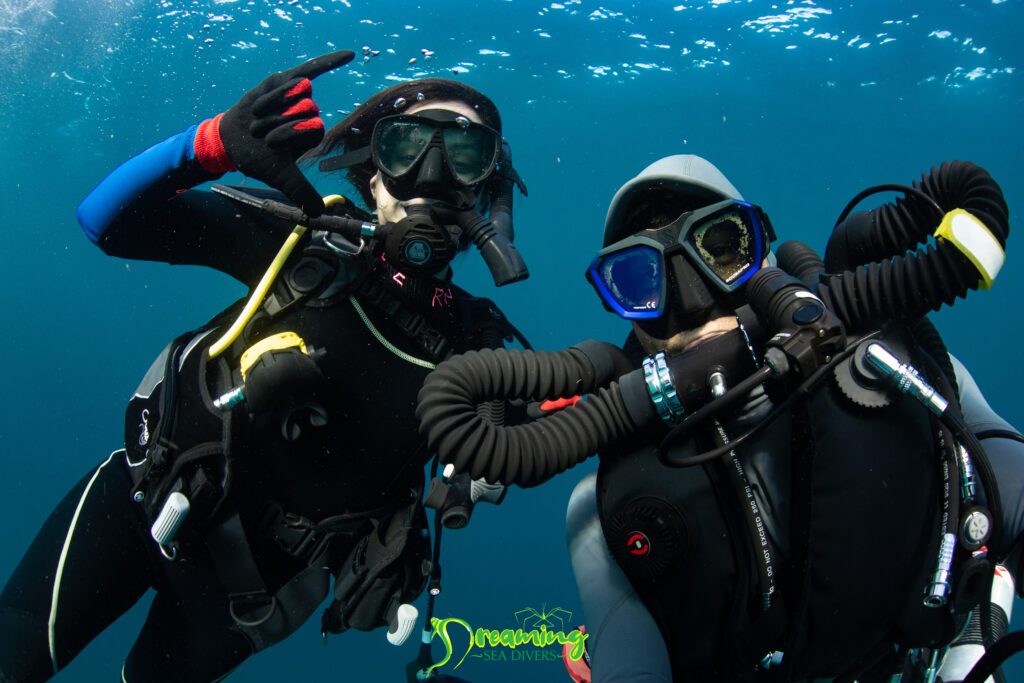
This course grants participants the knowledge to teach and certify students from Open Water up to the Divemaster level. Through the Instructor Development portion of the course, you will learn how to teach to the standards of SCUBA Diving International. Scenarios will be presented to test your aptitude in dealing with potential difficulties students may have along the way. We’ll also go over the business aspects of diving so you can be armed with the know-how to make diving a career. From there, you will be evaluated on your instruction abilities.
Those interested must be 18 years or older, have a minimum of 100 logged dives, and must bring their own SCUBA equipment. A Divemaster or Assistant Instructor and CPR Certification from a recognized agency is a prerequisite. Throughout the course’s instructional workshops, participants will learn about:
Please note that the Instructor Development Course does not include rental gear, so come prepared! It does, however, come with the Pro OWSI Kit. For more information, visit the course event page. Come learn from a renowned South Florida SCUBA diving certification instructor, and leave with the experience to start your own operation!
As an avid diver, you know that your skills and equipment can take you to places otherwise unimaginable. The best way to show the world below the surface to others is educate and get them physched about diving.
When taking one of Dreaming Sea Divers’ Instructor Development Courses, you’ll go home with the necessary skills to begin your journey as a professional dive instructor. Reach out to John and the crew to reserve a spot on our SCUBA West Palm Beach diving course roster. We’ll see you with fins on and an appetite for learning!
Dreaming Sea Divers is located in West Palm Beach, Florida; one of the best diving locations in the world. Renowned for its diverse marine life, variety of reef depths, and close proximity to the Gulf Stream, West Palm Beach has a little bit of everything. Our Florida SCUBA diving lessons are your ticket to beautiful scenery, remarkable aquatic life, and an unmatched location. See why you should book an experience with Dreaming Sea Divers!
SCUBA diving FL has a bounty of wrecks and reefs! There’s Breakers Reef, a two-mile long stretch of coral reef that's home to Caribbean tropical marine life, green morays, spiny lobster and fish from the Pelagic zone. Next is The Corridor, known as a collection of “shipreefs” for hosting many wrecks that you can dive to on a single tank. Mere minutes from the Palm Beach Inlet, you can find the 185-foot Greek luxury liner Mizpah in 90 feet of water, the retired PC1170, a 165-foot patrol boat sitting off of its bow and a path of rubble leading to the Amaryllis: a massive 441-foot freighter that slammed into Singer Island in ‘65.
When you come our way for West Palm Beach SCUBA diving lessons, you'll be amazed at the scenery in our clear blue waters. The shallowest depths we dive to in the reefs are 40 feet on top and 60 feet in the sand. Our deeper reefs start at 65 feet and drop to 90 feet in the sand. Many of our reefs have a double ledge system advantage where we can weave back and forth to save us bottom time and explore the view. This includes several wrecks starting at 65 feet down that have been intentionally sunk to attract marine life and promote coral growth. Some of these wrecks are even accessible to enter and look around inside!
May through August are the best months to observe leatherback, green, and loggerhead turtles nesting on the beaches and swimming back to the reefs. We see plenty of hawksbill turtles as well, though they don’t mate and nest here in Palm Beach. On our “Wreck Treks,” we are often joined by schools of Goliath grouper fish, and sometimes we see several species of sharks which can be photographed safely from a distance. Between August and September, it's possible to see over 30 giant groupers that congregate here to mate.
The dive sites we visit are populated with many species of moray eels, angelfish, butterfly fish, grunts, and snappers. Occupying our reefs are loggerhead, Kemp’s Ridley, hawksbill, and green turtles, octopus and squid, and anemones that house tiny shrimp. If we’re lucky, the manta rays, whale sharks and great white sharks may make a special appearance!
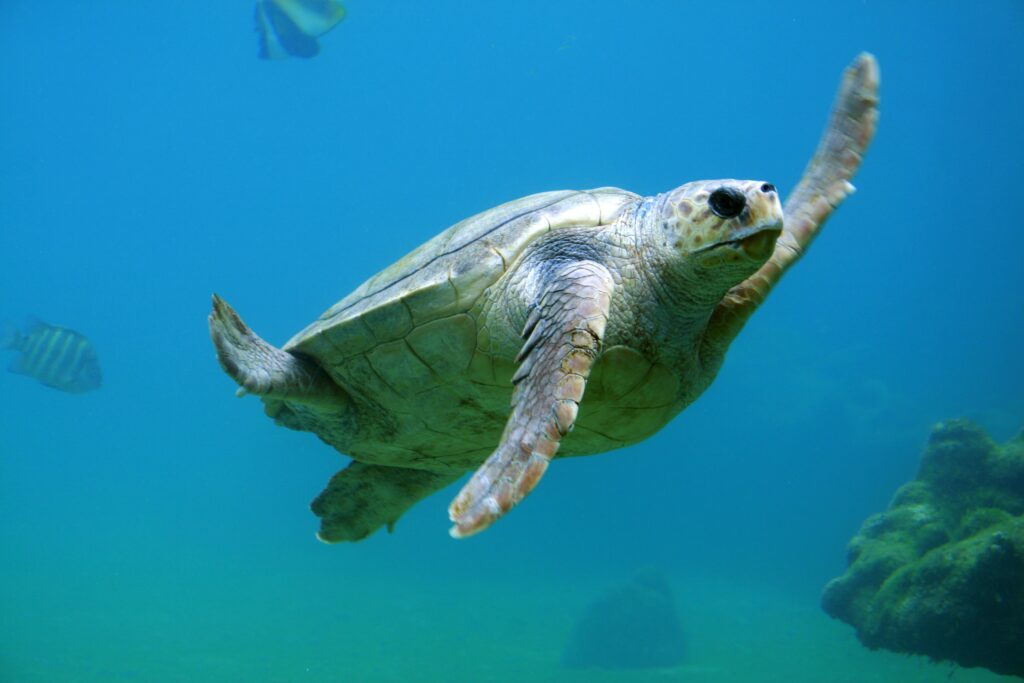
Our reefs are full of game fish and crustaceans, if you want to dine after your dive! Palm Beach hosts crabs, lobsters, clams, scallops, hogfish, snapper, grouper and cobia. Lobster hunting season is early August through the end of March, if you want to catch dinner eight months out of the year! Spotting the spikey lionfish is probably the coolest, though not so much for our reefs. This species is invasive and harms the reefs - but you could help by catching them to eat, if they suit your palette.
Blue Heron Bridge at Phil Foster Park is a world famous dive site, right here in Palm Beach. Divers have come here for decades to observe and photograph rare marine life that are hard to find elsewhere. These include batfish, frogfish, seahorses, manatees, sea robins and flying gurnards, bumblebee shrimp, spotted eagle rays, yellow spotted stingrays and pipefish. In addition, you can enjoy many types of blennies, tropical fish, and eels. What more could you ask for? Something else great: the deepest spot here is 23 feet, which means we do not have to be concerned about decompression limits. Keep in mind though, we are limited here by a daily two-hour window based around Slack High Tide (the weakest currents) and air consumption. We'll go over all of that during your South Florida SCUBA diving certification.
Jupiter
Jupiter is referred to as a small drinking town with a fishing problem. There is a famous lighthouse that’s worth climbing and plenty of fun shops and wonderful restaurants, some right on the water. The Square Grouper restaurant is the site where Jimmy Buffet recorded the music video for “It’s Five O’Clock Somewhere” with Alan Jackson. The diving is slight deeper and the currents are normally a little stronger than Palm Beach, but the reefs are filled with tons of life. There are also some exciting wrecks and good hunting spots in Jupiter as well.
Fort Lauderdale
Known as the “Venice of America,” Fort Lauderdale residents are passionate about the water and watersports. There is an artificial reef program that has sent dozens of wrecks to the seafloor, along with three retired oil platforms known as the Tenneco Towers. While these are cool to explore, you may find that several grunts, snappers, sponges and sometimes bull sharks are attracted to these as well!
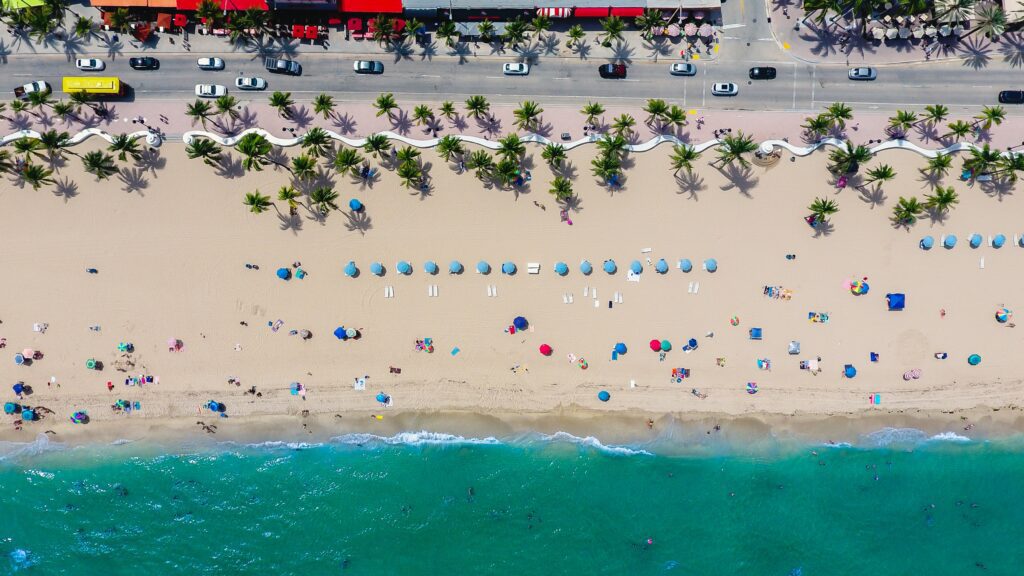
Miami
While best known for its pop culture and beach life, Miami is also a secret diving hub with wrecks that can be visited on a single tank. Go-to sites include the Miss Patricia (a 65-foot steel tug), two M60 tanks, the 110-foot Billy’s Barge, Ben’s Antennae Reef and the Miss Karline, a 100-foot ship lodged in the sand near the Patricia. But, the best is for last: The Spirit Of Miami, a retired Boeing 727 that made its final landing off Key Biscayne!
To prepare you for all dive sites in South Florida we may visit, you should know that water temperatures range from the mid 70s in winter to the mid 80s in summer and visibility is generally in the sub-100-foot range.
Dreaming Sea Divers will ensure that your dive trip in South Florida is easy, comfortable, and the experience of a lifetime! Become a certified diver through our private SCUBA courses and then embark on a private guided underwater tour with instructor John starting at the Blue Heron Bridge, or on one of the many comfortable dive boats! Get in touch with Dreaming Sea Divers today to plan and embark on your unique South Florida diving adventure!
Special note: Interested in becoming a Dive Professional? Check out John's upcoming Instructor Development Courses going on from October 16th - 24th 2022. SPACE IS LIMITED, SIGN UP TODAY!
With the modern invention of the SCUBA tank, exploration of the oceans has been changed dramatically, but still, people continue to free dive. Ancient people all around the world have been exploring the oceans for centuries without an air cylinder.
However, in the debate of SCUBA diving vs. freediving, the differences go deeper than just the equipment. While both are a similar adventure, the technique and overall experience between the two is vastly different, and each person has a particular perception of the dive. It is truly a matter of taste.
The most obvious difference between SCUBA diving vs. freediving is the use of an air tank and other relatively cumbersome equipment like masks, gloves, regulators, depth gauges, and in today’s age, a dive computer. In contrast, while you really don’t need anything to go free diving, the most basic equipment includes a mask and fins. It’s also common to wear a wetsuit and a snorkel depending on your objective. With freediving, the most important thing you dive with is your dive buddy.
When people started using tanks to explore oceans the technique had to evolve with the technology. SCUBA divers must pay careful attention to their ascents, descents and take routine safety stops to avoid decompression sickness. They have to be aware of the nitrogen levels in their bodies. This makes SCUBA diving a slower, more thought out adventure than freediving.
On the other hand, freedivers don’t have to worry about nitrogen levels or slow ascents and descents. Freedivers have much more maneuverability than SCUBA divers. However, freedivers are challenged to hold their breath throughout the entire dive. Freediving requires a great deal of practice and training to be able to stay down for an extended period of time.
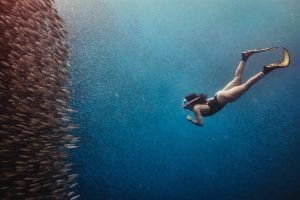
While the differences in gear affect the technique, the technique affects the experience. So if you’re SCUBA diving, you will have the advantage of staying underwater for longer. The longer you stay down, the more time you have to observe marine life and underwater geographical features. This means the longer you stay underwater, the more your eyes will adjust to the dark lighting which can increase the vibrancy creating a totally different image than a freediver. The length of time also influences how much you can explore. For example, if you’re going down to an underwater shipwreck or canyon you will be able to explore it more thoroughly.
However, freediving also has its benefits. Without the need for a tank, a freediver is able to swim smoother through the water and have a different experience with marine life. There is no added noise or disturbance because you are simply holding your breath. This can allow a freediver to get up close to schools of fish or turtles without scaring them off.
It has also been pointed out by avid ocean explorers that one of the biggest differences between SCUBA diving vs. freediving is the sense of awareness. When you are SCUBA diving you are enabled to mainly focus externally on your surroundings and gear. You are constantly analyzing these things and reacting to external forces underwater.
In freediving, it has been described as a more inward-focused experience where you are challenging yourself while still exploring. Your perception of yourself and your surroundings are altered when your mind is in a survival state, and you have to pay careful attention to what your body is telling you.
While the debate of SCUBA diving vs. freediving can go on forever, Dreaming Sea Divers has the best of both worlds. Here at Dreaming Sea Divers, we offer classes and guided experiences for both types of diving. If you have any questions or want to learn more about us, head over to our contact page or give us a call at (607) 624-6770.
SCUBA diving is a sport that many people have heard about, whether it was in movies or on television, in the news, or in books they had read. Some take an immediate interest in it and some stay on the sidelines and don’t really revisit the topic. The training agencies are all standardized so that we all teach the same curriculum across the different agencies with very little variation. But unless you’re learning from a certified diver who’s absorbed the material well, you may have been misinformed about what exactly SCUBA Diving involves. Here’s a list of some of these misconceptions!
Even some of my favorite TV shows (i.e. Money Heist, Season 3) get this wrong and it’s frustrating because it comes off as lazy to assume this is true and not do five minutes of research. Recreational (non-commercial or no decompression divers) do not use pure oxygen while diving. What we use at the entry-level is what we refer to as “Air”. It is comprised of the same mixture of Oxygen (~21%) and Nitrogen (~79%) that is in our atmosphere that we take in with every breath here on the surface. In your Open Water Diver Course, you will learn why this is safe. In your Enriched Air Nitrox course, you will learn how to use more than 21% oxygen, but no more than 40% oxygen safely and why divers choose to do so.
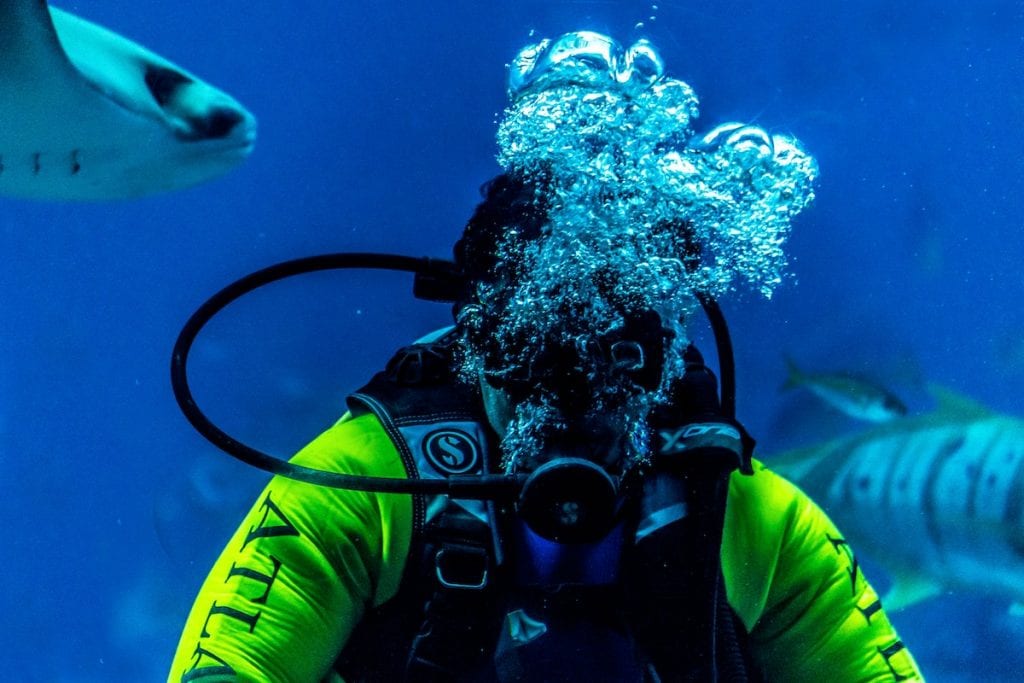
Okay, I know I just threw some numbers at you, but there is little math and physics that you need to truly memorize. What you do learn is how pressure affects us and our bodies, about the gas that we breathe, and how pressure increases the deeper we go. We benefit so much from technology in the 21st century in so many facets of our lives and diving is no different. Computers keep track of how deep we are, how long we have been down, and where our limits are in depth and time. This is all calculated in real-time. You need only to understand the concepts of what the computer is doing. Blindly following any computer is unsafe. Once you know the basics of diving physics, you know how to trust your computer.
Why would you run out of air? Air management is a vital and simple skill. The basic rule is: pay attention. This is a very preventable emergency. You learn how to avoid running out of air by monitoring your gas, letting your buddy know how much air you have, and learning when to leave the bottom. Another beautiful thing about technology is that some computers also know how much air you have and can alert you when you get to a preset amount.
In the mid-1900s, Freedivers were defying what so many physicists hypothesized. That is, that the enormous pressure of the ocean would crack a man’s ribcage past a certain point (~100m/333ft). The truth is, our bodies are well prepared to survive incredibly deep dives with the proper training. Pressure affects air spaces and the air spaces we take down with us are our mask, ears, sinuses, and lungs. The ears and the mask are the most noticeably affected by the pressure and in these air spaces. Have you ever tried to dive to the bottom of the pool and experienced discomfort in your ears? Have you ever had sinus or ear discomfort on an airplane? The physics are the same. We simply need to blow out of our nose gently while pinching our nostrils and we do this before we experience discomfort.
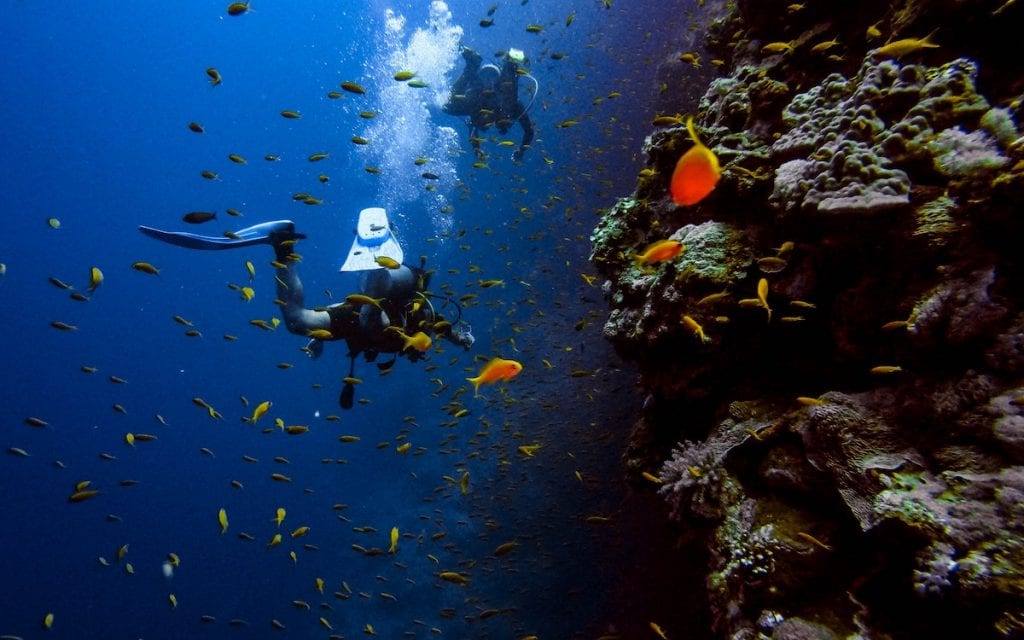
This could turn into a physics lesson but the truth is, I’m not qualified to teach it! Water does absorb light and color, yes. But natural light penetrates the ocean and other bodies of clear water for hundreds of feet. You would bring a light if you wanted to look into crevasses in the coral or perhaps under ledges. We do this especially when we’re hunting for lobsters. Underwater photography also calls for additional light sources sometimes, but not always. In general, you needn’t worry about the darkness of the ocean.
Swimmers who have trained and competed in, say high school or college, do generally make good divers. This, however, is not a prerequisite. Children as early as 8 years old can try SCUBA in a pool and students as young as 10 years old can be Junior Open Water Diver certified to a depth of 40ft. There are also handicap-able SCUBA divers. I once spent two days doing exploration dives with a 17-year young woman who was only able to use one leg. Divers come in many forms and the sport does not disclude people who don’t regularly swim laps. While diving, you’re using your legs with the help of fins for propulsion and the way you move through the water on SCUBA is very different than swimming laps.
The truth is, we’re going into the sharks' house and we’re so lucky when we get to see sharks in the wild. We’re wearing a SCUBA unit that makes us sound like Darth Vader when we breathe. We also blow bubbles while we breathe. Sharks are not used to hearing Darth Vader and they’re not used to seeing bubbles in the water so our breathing generally scares them away. If we don’t bring dead fish with us in the water or shoot a fish while we’re there, sharks stay at a very safe distance from us and sadly don’t normally come close enough for a great photo. It’s rare moments when we get a good shot and a closer interaction but I’ve spent years diving with sharks and have never seen them be aggressive towards divers. I’ve never been bothered by barracudas either.
The founder of Dreaming Sea Divers (DSD), John, knew he was ready to branch out and start his own company, and start training people the way he has seen his students learn the best. That is, at their pace, in an unintimidating environment, in a private SCUBA class with their instructor, who is there every step of the way. This personal and private approach separates him from the rest by eliminating the large groups at a devastating discount with fine print. The positive approach John employs sets him apart from some militant type instructors with scare tactics. John has more tools in his toolbox.
Well, you can’t have a business without a name and Dreaming Sea Divers is personal to John! He’s has had a strong affinity for Dave Matthews Band since high school, referring to them as his “desert island band”. Of their vast catalog of songs, John chose a song that he could relate to the ocean, “The Dreaming Tree.” This song is about an old man reminiscing of a tree he used to sit under and think. He used to climb it with a girl that he shared his first kiss with. Sadly, the tree dies because of the progress of the world. Coral bleaching and plastic ending up in the ocean is perhaps a topic for a different blog but the similarities between a tree dying and the ocean needing advocates were obvious to John.
As we said before, Dave Matthew Band has a huge catalog of original songs and performs dozens of covers live. They’ve never played the same show twice, each song is different from night-to-night.
Diving is just like this! No two dives are the same. You never know what you'll see, who you may end up diving with, or where your diving endeavors may take you! John has a huge place in his heart for music, diving, and education. He loves learning new music as much as he loves learning and spreading his knowledge and skills of diving.